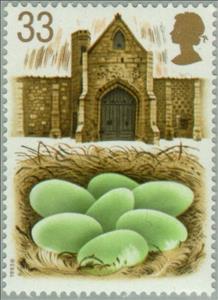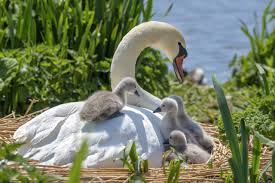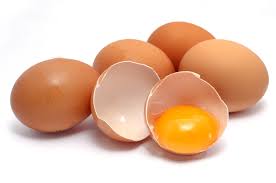Stamp: Eggs in Nest, Tithe Barn - Abbotsbury (United Kingdom of Great Britain & Northern Ireland 1993)
Eggs in Nest, Tithe Barn - Abbotsbury (United Kingdom of Great Britain & Northern Ireland 1993)
19 January (United Kingdom of Great Britain & Northern Ireland ) within release 600th Anniv of Abbotsbury Swannery goes into circulation Stamp Eggs in Nest, Tithe Barn - Abbotsbury face value 33 British penny
| Stamp Eggs in Nest, Tithe Barn - Abbotsbury in catalogues | |
|---|---|
| Michel: | Mi:GB 1429 |
| Yvert et Tellier: | Yt:GB 1648 |
| Stanley Gibbons: | Sg:GB 1642 |
| AFA number: | AFA:GB 1576 |
Stamp is vertical format.
Also in the issue 600th Anniv of Abbotsbury Swannery:
- First Day Cover - 600th Anniv of Abbotsbury Swannery - FDC face value 1.42;
- Stamp - Mute Swan (Cygnus olor), St. Catherine's Chapel face value 18;
- Stamp - Juvenile Mute Swan (Cygnus olor), Duck Trap face value 24;
- Stamp - Mute Swan (Cygnus olor) face value 28;
- Stamp - Eggs in Nest, Tithe Barn - Abbotsbury face value 33;
- Stamp - Young Mute Swan (Cygnus olor) face value 39;
Stamp Eggs in Nest, Tithe Barn - Abbotsbury it reflects the thematic directions:
Birds (Aves), a subgroup of Reptiles, are the last living examples of Dinosaurs. They are a group of endothermic vertebrates, characterised by feathers, toothless beaked jaws, the laying of hard-shelled eggs, a high metabolic rate, a four-chambered heart, and a strong yet lightweight skeleton. Birds live worldwide and range in size from the 5 cm (2 in) bee hummingbird to the 2.75 m (9 ft) ostrich. They rank as the class of tetrapods with the most living species, at approximately ten thousand, with more than half of these being passerines, sometimes known as perching birds. Birds are the closest living relatives of crocodilians.
Swans are birds of the genus Cygnus within the family Anatidae. The swans' closest relatives include the geese and ducks. Swans are grouped with the closely related geese in the subfamily Anserinae where they form the tribe Cygnini. Sometimes, they are considered a distinct subfamily, Cygninae.
Humans and their hominid relatives have consumed eggs for millions of years. The most widely consumed eggs are those of fowl, especially chickens. People in Southeast Asia began harvesting chicken eggs for food by 1500 BCE. Eggs of other birds, such as ducks and ostriches, are eaten regularly but much less commonly than those of chickens. People may also eat the eggs of reptiles, amphibians, and fish. Fish eggs consumed as food are known as roe or caviar.
Animals are multicellular, eukaryotic organisms of the kingdom Animalia (also called Metazoa). All animals are motile, meaning they can move spontaneously and independently, at some point in their lives. Their body plan eventually becomes fixed as they develop, although some undergo a process of metamorphosis later on in their lives. All animals are heterotrophs: they must ingest other organisms or their products for sustenance.




